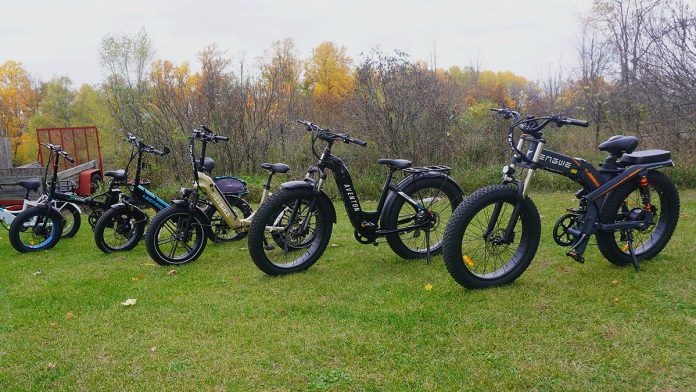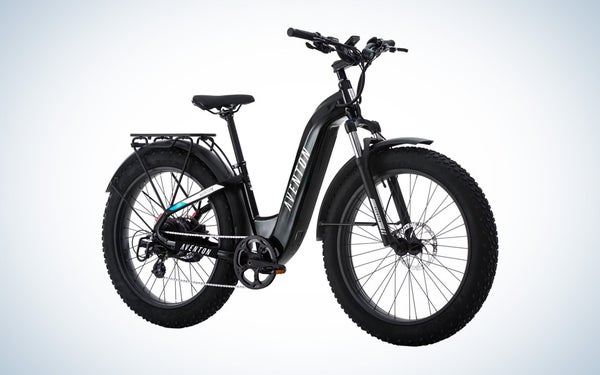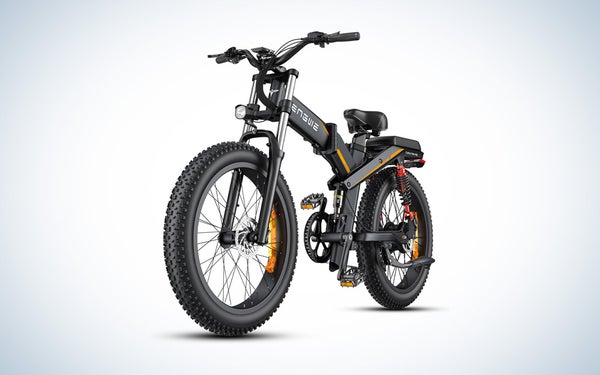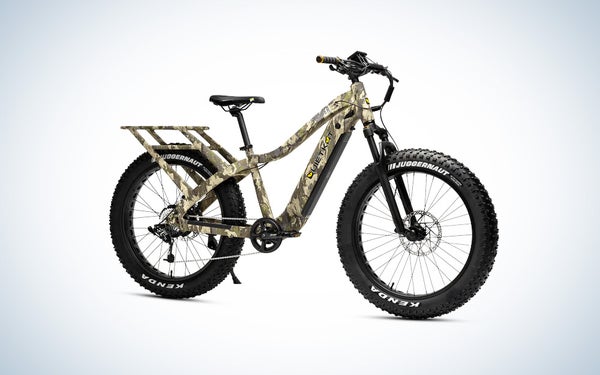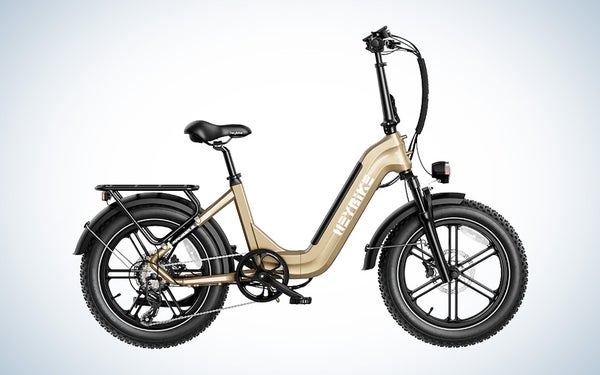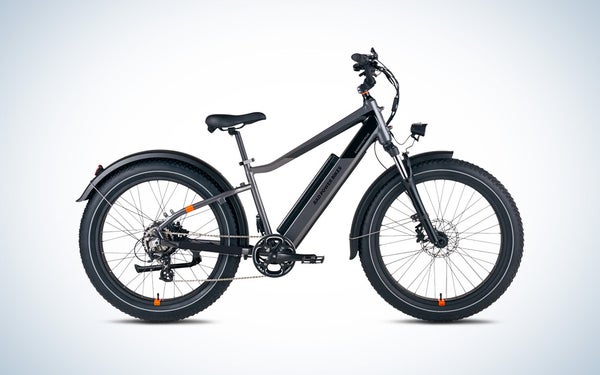We may earn revenue from the products available on this page and participate in affiliate programs. Learn more ›
While electric bikes seemed like a fad at first, it’s safe to say they are here to stay. And for good reason. Once you use an e-bike, it’s hard to go back to a more traditional style. They’re efficient, versatile, and just downright fun to ride. Plus, hunters and anglers have found fun and innovative ways to use e-bikes to access hard-to-reach honey holes.
However, stores and online retailers have become over-saturated with different brands and styles of electric bikes. Wading through dozens of options can be time-consuming and more than a little frustrating. Trust me, I’ve done it myself. That’s why we’re here to help. We’ve done all the research and the testing required to help point you in the right direction. Which includes riding a number of bikes from the most popular manufacturers. We tested them in all types of terrain so you can find the right bike for hunting, fishing, or off-road riding. Here are the best electric bikes being made today.
How We Chose the Best Electric Bikes
I’ve tested a number of e-bikes on a variety of terrain—from paved roads to dirt jumps—over the last three years. And this in-the-field experience has helped me differentiate useful features from pointless gimmicks. Many of the e-bikes you’re about to see were tested specifically for this review.
My testing process consisted of riding at least 50 miles on each bike while also evaluating speed and battery life. I also took notes on assembly, maintenance, and user-friendliness. Toward the end of my test and comparisons, I was able to categorize each bike into a best-case scenario, which you will see below. I also considered the following factors in my selection:
- Off-Road Capabilities: Can this bike seamlessly transition from dirt to pavement? Or is it strictly a city bike?
- Power: What is the bike’s top speed? How much effort does it take to get the pedal assist to engage? Can it haul a heavy load?
- Comfort: What features does the bike have to smooth out the ride? Is the stock seat comfortable?
- Accessories: What sort of add-ons does the manufacturer offer? Is the price point fair for these additional items?
- Value: Is the price point fair for the style and features of the bike? Does this bike require a ton of upgrades for an optimal ride?
Best Electric Bikes: Reviews and Recommendations
Best Overall: Aventon Aventure.2
Specs
- Price: $1,799
- Motor: 750-Watt Brushless
- Brakes: Hydraulic disc
- Tires: 26” Fat Tire
- Weight: 77 Pounds
Pros
- Torque sensor pedal assist is super smooth
- Excellent price point for this style of bike
- Great battery life
- Turn signals and brake lights
Cons
- Stock seat is extremely hard
The Aventure.2 has quickly become one of my favorite electric bikes for its smooth ride and excellent build quality. My only real complaint is that the stock seat is a little hard for my liking. But I rode this bike 45 miles on the first battery charge with ease. And I believe I lost a little range on the back end as the temperature dropped, decreasing the battery life. I’m anxious to see what it does in warm weather. The torque sensor makes for a smooth ride that also provides a great workout. The Aventure.2 has a gradual take-up of speed on both assist and throttle that’s safer and won’t jerk the rider around like other bikes.

The grips have a tiny bit of tact that makes them extremely comfortable for longer rides. The throttle is on the left side, but I found it quite natural and intuitive to operate even though I’m right handed. And I found the bright display screen is super easy to read in any lighting conditions.
I got this bike up to 26 miles per hour going downhill, which felt plenty fast enough for a bike of this size and weight. The beefy construction gives it a lot of strength, which meant I felt comfortable taking it for short, off-road jaunts. The front suspension fork has a nice amount of travel that I found helped soak up some of the worst speed bumps in my neighborhood.
The Aventure.2 was also shockingly easy to assemble because of the great fit and finish of the build. Nothing on this bike feels cheap or out of place. And nothing feels forced either. Considering Aventon recently dropped the price point to $1,800 permanently, it’s an incredible deal for a bike with these features and capability.

Best Value: Lectric XP Step-Thru 3.0
Specs
- Price: $1,199
- Motor: 500-Watt hub with a 1,000-Watt peak
- Brakes: Hydraulic disc
- Tires: 20” Fat Tire
- Weight: 64 Pounds
Pros
- Exceptional good looks
- Great range
- Tons of available accessories
Cons
- Terrible key placement
- Pedal assist level one is not useful
Lectric is one of the most popular e-bike brands, and it’s easy to understand why after riding one. My parents bought a couple of these bikes because they fold in half and are easy to stow in their van while on camping trips. I topped this bike out at 21 miles per hour during testing. It is capable of light off-roading thanks to a generous front oil suspension fork. The range is also solid. And because the bike is geared well enough to ride without assist, one doesn’t need to worry as much about the battery running out.
Pedal assist level one is not as useful as I’d like. It doesn’t provide much of a boost when compared to pedaling without. This isn’t a deal breaker in my mind though. It just means the bike needs to be ran on level two or above. I spent most of my time in level three during testing. That seems to be the sweet spot for performance with this bike. The $1,200 price point also makes this bike an incredible value for the money. In my opinion, it’s the best 20-inch folder out there right now.

Fastest: Engwe X24
Specs
- Price: $1,699
- Motor: 1,200-Watt Peak High-Speed Brushless
- Brakes: Hydraulic Disc
- Tires: 24” Fat Tire
- Weight: 96 Pounds
Pros
- Extremely fast
- Aggressive suspension
- Dual batteries provide great range
Cons
The X24 is the fastest electric bike I tested. It topped out at 29 miles per hour on a paved downhill road. While I tried my best to get it over 30, it just wouldn’t break that threshold. The Engwe is ideal for off-roading because it has three points of suspension that really soak up the ruts and bumps. This is a bike that riders can be aggressive with and take on off-road trails. It is the closest thing to a mountain bike I found of all of the models I tested.

The aluminum alloy frame of the X24 is extremely robust. I’ve never seen a folder this rugged before. But the frame needs to be exceptionally strong because Engwe gave this bike not one, but two batteries. There’s a 19.2-amp hour battery and a 10-amp hour battery. A simple press of the button allows the rider to turn the extra one on or off, depending on your needs. Engwe advertises a 62-mile range for the X24, but I got about 50 miles off a full charge of both batteries. However, I was also testing in 50-degree temperatures, so I came away rather impressed by that battery performance.
My only real complaint is the extra battery adds about 20-30 pounds to the bike. At 92 pounds, it’s not impossible to pick up, but it is tough to wrangle into a smaller vehicle. But the $1,699 price point, solid range, and ruggedness of the build are all standouts.

Best for Hunting: Quiet Kat Ranger
Specs
- Price: $3,599
- Motor: 1,000-Watt Hub Drive
- Brakes: Tektro 2-Piston Hydraulic
- Tires: 26” Fat Tire
- Weight: 65 Pounds
Pros
- Nearly bulletproof
- Great suspension
- Surprisingly lightweight
Cons
Quiet Kat remains one of the most impressive electric bikes I’ve ever pedaled. The smooth handling and rugged open frame of the bike make it capable of tackling terrain that would break other models. I took one of these Rangers over some serious jumps during a test ride last year. The suspension soaks up the impact and the aggressive tread on the tires helps it dig in and out of corners like a motorbike. The 1,000-watt hub motor gives the bike a ton of torque and capability that’s hard to match for other bikes of this size.
These bikes are a popular choice for hunters who need something to handle the elements. One of my former co-workers completely submerged one of these bikes in a massive puddle on a turkey hunt in Illinois. The Quiet Kat shrugged it off and kept on running. Pair that with a 325-pound load capacity, and you’ve got a bike that will not only get you to that big buck, but will pull it out for you too.
The aggressive motor does mean these bikes have a slightly shorter range than some of the others on this list. They are also very expensive, but you’ll be hard pressed to find a tougher bike capable of going deep in the backcountry. It’s a serious hunting bike for the most dedicated hunters out there.
Most Sporty: Heybike Ranger S
Specs
- Price: $1,399
- Motor: 750-Watt Brushless
- Brakes: Hydraulic Disc
- Tires: 20” Fat Tire
- Weight: 72 Pounds
Pros
- Extremely peppy assist and throttle
- Complete package is stock
- Great brakes
Cons
- Tough to assemble
- Plastic fenders
“Spunky” is a very appropriate description of the Ranger S. It’s peppy with a surprising amount of torque for a dead start using both the throttle and the assist. I wouldn’t recommend it for kids, but it’s a super fun ride for adults (it wheelies quite easily). And I topped this bike out at about 22 miles per hour, but it feels faster than that.
I didn’t think I was going to like this bike after a tough assembly. Many of the nuts, bolts, and parts had a difficult fit. I can normally assemble an electric bike in under an hour. This one took two. However, this bike grew on me quickly in the first 50 miles I put on it. It has a very smooth ride, and surprisingly enough, the stock seat is one of the better ones I’ve seen on an electric bike.

Another thing I like about the Ranger S is just how complete the standard package is compared to similar-priced bikes. This model comes with full lighting, turn signals, an LCD display screen, and even an electronic horn. I got about 28 miles off the first charge with this bike. But keep in mind it was rather cold during my testing. I expect it will come much closer to the advertised 55-mile range once warm weather returns. The folding mechanisms also lock down securely. It was a breeze to take down and throw in the back of my van. This is a solid, complete package for anyone looking for a folder in the $1,500 range.

Best Commuter: Rad Bikes RadRover 6
Specs
- Price: $1,399
- Motor: 750-Watt Brushless
- Brakes: Hydraulic Disc
- Tires: 24” Fat Tire
- Weight: 73.4 Pounds
Pros
- Extremely comfortable ride
- Excellent suspension
- Transitions well between on and off-road
Cons
- Replacement parts are an issue
Coupled with an improved saddle, the RadPower offers an incredibly cushy ride—perfect for commuting. It is one of the most comfortable bikes I tested, both on and off-road. I cruised around small town streets for hours on this bike and even took it down some infrequently used dirt paths. It only used up a small portion of the battery each time.
This RadRover 6 has a cadence sensor, but it’s one of the better ones I’ve seen on this style of electronic bicycle. The pedal assist isn’t overwhelming either and feels rather close to a torque sensor. This is a solid option if you want to actively shift between the gears.
One of the biggest issues a friend of mine has had with his RadRover is finding secondary market replacement parts. That means he’s been forced to buy more expensive parts directly from Rad Power. Still, Rad Power has recently dropped the price point of this bike, making it incredibly affordable from where it was a few years ago.
Best Budget Folder: Ecotric 500-Watt Folding
Specs
- Price: $619 – $699
- Motor: 500-Watt Brushless
- Brakes: Mechanical Disc
- Tires: 20” Fat Tire
- Weight: 65 Pounds
Pros
- Extremely affordable
- Excellent folding mechanisms
- Rugged frame
Cons
- No suspension
- Mushy brakes
The Ecotric was my first electric bike has yet to let me down. It’s a rather simple design that’s great for anyone on a budget. The price has dropped since I first bought mine during Covid. It was originally $880, but is now $699. And it’s a very solid bike for that price. I’ve taken this bike off-road, through bumpy cornfields, and over muddy trails. It will handle anything you throw at it.
You do feel the bumps while riding this bike due to the lack of a front suspension fork, but it isn’t horrible. My only other complaint is that the mechanical disc brakes are mushy, and not nearly as smooth as hydraulic ones. This bike will easily do 20 – 22 miles per hour, depending on the terrain, conditions, and battery. While the motor is only 500 watts, it’s surprisingly sporty. It takes off in a hurry with a twist of the throttle.

I highly recommend paying extra to get the LCD screen display. One of my biggest regrets was going with the LED light display. It’s functional, but also hard to tell exactly how much battery life is left due to voltage sag when the motor is assisting. Overall, this is a tough little bike packed full of great features that normally can’t be found at this price point. In fact, I’m not even sure how Ecotric makes money on these things for the prices they offer.
What to Consider When Choosing an Electric Bike
With electronic bikes, most people are concerned about range and price. But you need to take the advertised range with a small grain of salt because most manufacturers list the mileage for the lowest assist settings. This is fine, but I know a few e-bike users who actually ride at level one, including myself.
External factors like throttle use and ambient temperature can also affect how quickly the battery drains. About half of my testing for this article took place in temperatures reaching into the 40s and 50s. I know I wasn’t getting the maximum performance of these bikes in those conditions. That’s just the way these batteries work.
As far as price point goes, the adage of “you get what you pay for,” tends to ring true. Although I’ve tested plenty of bikes in the $1,000 to $1,500 price range that are perfect for most riders who want a simple bike for cruising and commuting. I recommend budgeting around $1,000 at a minimum for one.
Pedal Sensor
It’s not often discussed, but the type of sensor used to kick on the pedal assist affects how a bike will ride. The two main types used today are cadence sensors and torque sensors. Cadence sensors are much more common because they’re cheaper. Basically, a cadence sensor registers whenever a rider puts pressure on the pedals and signals the motor to kick in at whatever assist level the bike is set at. On some bikes, this results in an immediate small jolt as the motor kicks into gear.
A torque sensor is more sensitive and expensive because they don’t just register the pedals in motion. These sensors actively measure how hard the pedals are being turned and then translate that into an appropriate amount of assistance. The harder you pedal, the more the bike will help, and the faster it will travel.
It’s been my experience that cadence sensor bikes are much easier to ride because they immediately take off to a pre-determined speed setting. This type of sensor is great for anyone who wants minimal effort. However, a torque sensor is a much smoother ride that feels closer to a standard bicycle. That means more effort is involved to get the bike moving and keep it moving at speed. I would recommend a torque sensor bike for anyone who wants a bike for exercise.
Weight
The large, lithium-ion batteries required to run e-bikes are heavy. Which means it requires a much beefier frame to support the battery. This all adds to the weight. It’s not unusual for a bike with 20-inch tires to weigh 55 to 70 pounds. A bike with 24 or 26-inch tires can weigh 65 to 95 pounds. Thus, it’s worth taking the weight into consideration when choosing a bike.
Frame
Standard e-bikes have a horizontal tube or construction that usually rides high on the bike. This style of frame offers great strength and durability. But a step-through frame drops the horizontal portion at an angle that makes it easier to hop on and off the bike. This can come at the cost of strength, but many bikes are being built extremely beefy these days, so it’s less of a concern.
Frame choice is largely becoming more of a personal decision than anything else. Although a step-through is significantly easier for older riders or anyone with hip or leg problems. Simply because the rider doesn’t need to lift their leg as high to get on the bike.
Seats and Accessories
Almost every manufacturer now offers a bevy of accessories for their electronic bikes. Cargo racks and bags, rearview mirrors, locks, and more are now bonus offerings often sold directly by the manufacturer. Sometimes, these accessories are offered in bundle packages that can save the buyer a lot of money.
One of the more frustrating things I’ve encountered with e-bikes is uncomfortable stock saddles. Many manufacturers put hard seats on their stock bikes. Then they sell much nicer, cushier seats as part of a “comfort” package. It’s refreshing to see a few bikes like the Ranger S and the Engwe x24 have a decent saddle straight from the factory. But until that’s standard across the industry, it’s my recommendation to budget for a better saddle when deciding on a bike.
FAQs
Q: What are the three types of electric bikes?
There are three different legal classifications that most electric bikes fall under. Class one bikes have motors that kick in only while the user is pushing the pedals. Class two bikes have a throttle and can operate via pedal assist or by a throttle. Class three e-bikes operate via throttle or pedal assist but top out at faster speeds, closer to 28 miles per hour. Each state has differing laws regarding age limits and other legalities with each class of bike.
Q: How long do e-bike batteries last?
It depends on the bike, the type of battery, and how it is maintained. I have one bike with a battery that’s three years old and still going. For some bikes, that might be the maximum age before it’s time to buy a new one. Other bikes might have batteries that last closer to five or six years. Read the instruction manual carefully for battery care tips specific to your e-bike’s battery.
Q: How much should I expect to pay for an electric bike?
Because of the cost of lithium-ion batteries, and the brushless motors that power these bikes, anywhere from $800 – $4,000 is a realistic price. Although I’ve found a fair number of good bikes in the $1,000 – $2,000 price range. This style of bike is not cheap, but they are worth the price of admission.
Best Electric Bikes: Final Thoughts
The Aveton Aventure.2 continues to impress me with the comfort and smoothness of its ride no matter the terrain. It’s hard to find a bike that rides this well for under $2,000. It is also versatile enough to transition from a commuter bike to an off-road machine rather seamlessly. Add in the slick good looks, and this bike is the total package.
Why Trust Us
For more than 125 years, Field & Stream has been providing readers with honest and authentic coverage of outdoor gear. Our writers and editors eat, sleep, and breathe the outdoors, and that passion comes through in our product reviews. You can count on F&S to keep you up to date on the best new gear. And when we write about a product—whether it’s a bass lure or a backpack—we cover the good and the bad, so you know exactly what to expect before you decide to make a purchase.

